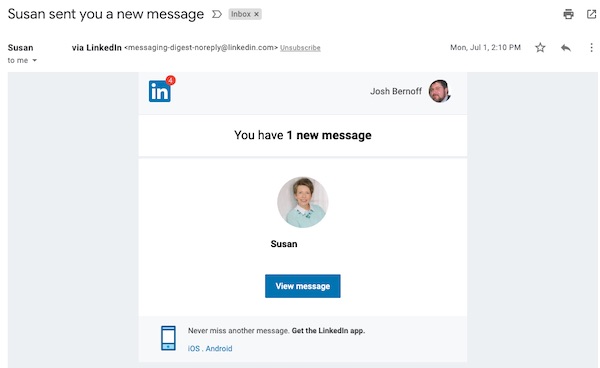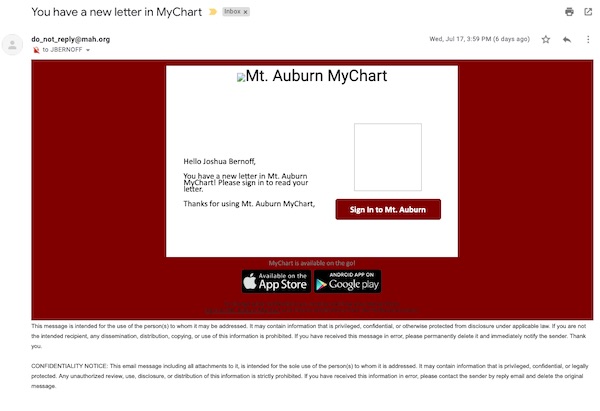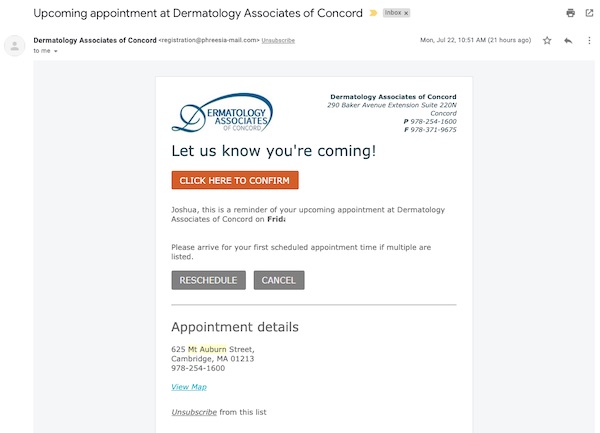Coy messaging apps aren’t just rude, they’re unsafe. (LinkedIn should know better.)
Want to contact me? Feel free to send me an email, a text message, a Twitter DM, a Facebook Messenger message, a Slack private message, a WhatsApp, or, God forbid, a voicemail. And you could, of course, message me on LinkedIn.
If you do choose to message me on LinkedIn, I’ll see something like this in my email:

Why so coy, LinkedIn? Before, you used to tell me what people like Susan wanted to say to me, but now, I have to click through to see it?
This is spreading. Here’s a message from my doctor’s office:

They get away with the broken links and missing graphics because hey, it’s from the doctor. What could it be? The test results about my lumbago? A bill? An alert about a contaminated vaccine?
Nah. It’s just a confirmation of the appointment I just made on the phone. Well, that’s one heart attack avoided.
And don’t give me your HIPAA excuses. Here’s what I get from my dermatologist (don’t worry about me, this is a routine skin check):

This tells me which doctor it’s from, includes the date, gives me a choice of rescheduling or confirming, and includes not just a phone number and an address but a link to a map. And I don’t think they’ve violated any regulations in the process.
More custom messaging is bad. But being coy is rude . . . and risky, too.
We’re all constantly bombarded with messaging from every possible direction. Every new app feel it has to include its own messaging channel. This is bad enough.
But a message that tells you nothing more than that you have a message is just infuriating.
It’s also unsafe. Imagine that you were a spammy scammer. What would you send? An email or text that tells the target to click through to see an important message. These messages from LinkedIn and my doctor would be very effective for phishing, except that they’re supposedly legit. How are we supposed to tell the difference?
If you’re developing a new application, it’s simple:
- If you can possibly avoid it, don’t add yet another messaging system along with your app.
- If you must include a messaging system, put the content of the message in the updates.
- Don’t tell people to click through to see an unknown message, because you look like a scammer.
Why does LinkedIn violate these principles?
To get you to return to the LinkedIn site or app to stimulate further interactions.
That’s an offensive abuse of my time. Really. Just show us the message, okay?
Facebook Messenger is equally guilty of being coy in its email notifications. I agree with you, Josh. Show me as much of the message as is possible. I’ll take it from there.
Emails from the doctor’s systems are subject to HIPAA, so they tend to use secure message systems (if for no other reason to cover their asses). I wish they would put more info in the subject line though like “Appointment Confirmation” or “Test Results” so I can gauge the importance of the info.
Agreed. My husband usually has three or four doctors’ appointments upcoming in the next month. A message like this from the umbrella medical organization doesn’t tell him which doctor or which appointment the message concerns. (To say nothing of the convoluted machinations he must engage in to access the message …)
And when you click through to LinkedIn from your phone, it grabs you by the lapels and demands that you install the LinkedIn app.
Not. Worth. It.
Agreed. I like that “grabs you by the lapels” visual. It does feel like that.
Better interface is needed to show regard for users’ time and attention. Both are valuable.